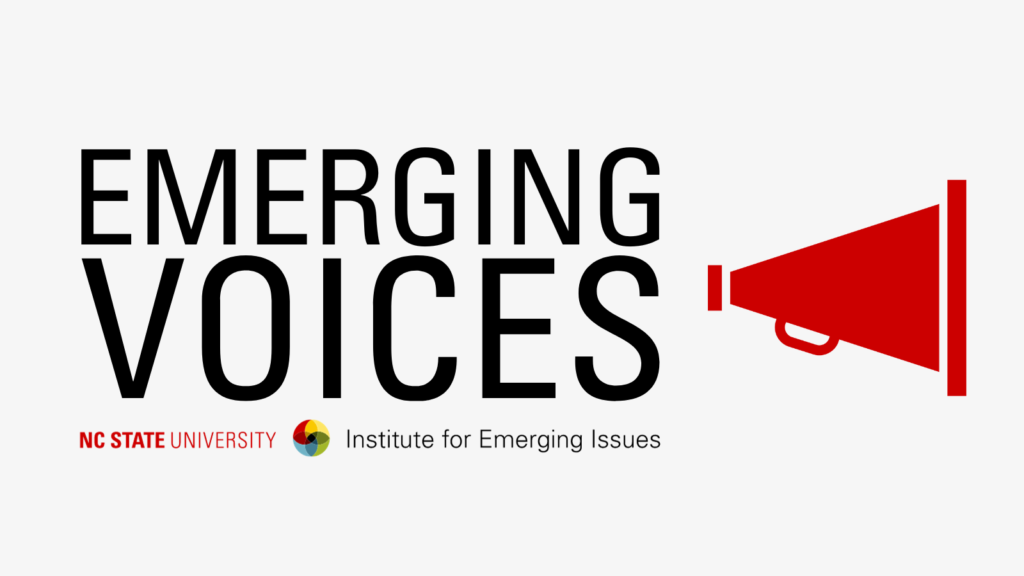What Does the NC State Budget Mean for Workforce Development?
Emerging Voices Blog Series

IEI is excited to announce the new Emerging Voices blog! This blog will feature stories from IEI interns, students from across the state and other up-and-coming voices about issues that matter to North Carolinians. Check out the first post from IEI Communications Intern Adam Sichel about the North Carolina State Budget.
As the Communications Intern for IEI, I am reporting on the Talent First Economics Community Cohort — five teams from across the state working locally across economic and workforce development. Each regional team is tasked with helping increase employment opportunities for underrepresented workers around the state, including but not limited to: transitioning military, people with disabilities and neurodiversity, families with young children, opportunity youth and justice-involved individuals.
In addition to the work taking place in communities around the state, the $30 billion North Carolina state budget for 2023-24 and 2024-25 includes several line items for education, healthcare and infrastructure related to workforce development. This article provides a high-level overview of these budget items.
Economic Development
The state budget has allocated roughly $3 billion in economic development initiatives. Here are a few examples of how these investments will drive workforce development.
- The Global TransPark (GTP) in Kinston will receive $350 million to assist the Fleet Readiness Center (FRC) East in creating a new military aviation depot. This partnership between GTP, FRC East and the U.S. Navy is estimated to create at least 400 new, high-paying jobs when the depot begins its repair and maintenance work in 2027.
- $130 million is directed toward supporting megasites. These are portions of land throughout the state that can be utilized for massive manufacturing and factory operations— typically over 1,000 acres. In order for megasites to be attractive to companies, the state is helping local governments improve infrastructure and other on-site preparations. Megasites support North Carolina workforce development goals by drawing large companies to the state, which in turn produces new jobs and economic opportunities.
Infrastructure
The state budget appropriated $2 billion for local governments to make water, sewer and infrastructure improvements. Of the 202 allocated projects, public health considerations took priority, followed by economic development needs. A primary example of the latter is Siler City in Chatham County, which received money to update its water and sewer capacity in order to support the new Wolfspeed Semiconductor plant. The plant, built on a megasite, is expected to generate 1,800 new jobs and several new housing developments for the town of 7,700 people.
Health Sector
The passage of the state budget triggered Medicaid expansion, which provided federally-funded health insurance coverage to approximately 600,000 North Carolinians who were previously unqualified. The expansion increases revenues for the state’s rural hospitals, allowing them to keep their doors open and maintain jobs.
Community colleges were given funding in the state budget for healthcare workforce development, addressing the shortages within the industry statewide.
- $30 million for start-up of programs
- $25 million for degree/credential programs
- $17.9 million for behavioral health workforce training
The budget also allocates funds across 14 different community colleges for specific health-related workforce programs. This primarily encompasses funding for health science education centers, expansion of healthcare programs and general improvements.
Neurodiversity
The state budget includes funding to address barriers faced by North Carolinians with Intellectual and Developmental Disabilities (IDD) when obtaining employment. This group not only faces barries in securing employment, but are often not provided the support needed to navigate the complexities of workforce systems. Here are some examples of efforts to remove those barriers.
- NC State’s College of Education received $6 million to launch their workforce and education pilot program for IDD individuals.
- The N.C. Department of Health and Human Services received $750,000 for a three-year pilot program that places vocational rehabilitation counselors for IDD students in community colleges.
- The N.C. Community College System received $4 million in recurring funds to create a regional support network that supports job training and employer networking for IDD students. This is an expansion of the pilot program utilized at Catawba Valley Community College and Brunswick Community College last year that saw high levels of success in helping IDD students earn credentials, skills and job offers. The money will also be used to hire employment achievement counselors at 15 community colleges, as well as fund a study on transportation barriers for IDD students.
Families with Young Children
Families with young children in North Carolina face significant barriers when it comes to accessing quality child care. This negatively impacts employment opportunities for parents who may not be able to afford child care or do not qualify for family-friendly workplace policies. Additionally, many child care centers face financial challenges due to high costs and severe labor shortages.
The following budget items affect workforce prospects for families with young children.
- $900,000 each year will go toward the state’s pilot Tri-Share program. In this program, the cost of child care is shared between the state, businesses and employees — meaning that eligible employees pay one-third the full price of child care. The pilot program will be rolled out in three counties, and the results will determine its viability in the future.
- $1.2 million is budgeted annually to help community college students with young children afford child care.
- $525,000 is budgeted annually for family home-based child care programs — a more affordable and smaller-class size option for many North Carolinians. Additionally, the budget allows for these programs to serve up to 10 students (up from eight).
- North Carolina’s Pre-K classrooms, which serve over one-fourth of the state’s four year olds, also are allowed to increase their class size to 20 students (up from 18).
Workforce Development in the Community College System
The state budget provided the N.C. Community College System with close to $1.5 billion in allocated funds over the biennium. The following community college projects are directly related to workforce development.
- Community colleges can grant up to $750 in additional funding per student for students pursuing short-term, non-credit industry credentials in the fields of architecture, construction, health sciences, information technology, manufacturing, electrical and various other high-demand programs.
- Brunswick, Wilson, James Sprunt, and Nash Community Colleges received a combined $60 million in funding toward their respective Workforce Development Centers.
- Sandhills Community College received $25 million to build a new Early College High School, focused on vocational career paths.
- Haywood Community College received $3 million and Cape Fear Community College received $1 million to go toward job training programs.
- Pamlico Community College received $650,000 annually to support their Prison Education Program, which has been successful in providing skills and credentials that help inmates at Pamlico Correctional Institute land job opportunities upon finishing their sentence.
As work continues to take place on the local level, the state budget demonstrates the collaboration between state and local government, the business sector, and the community college/university system in impacting employment opportunities for various populations in North Carolina.

- Categories:


